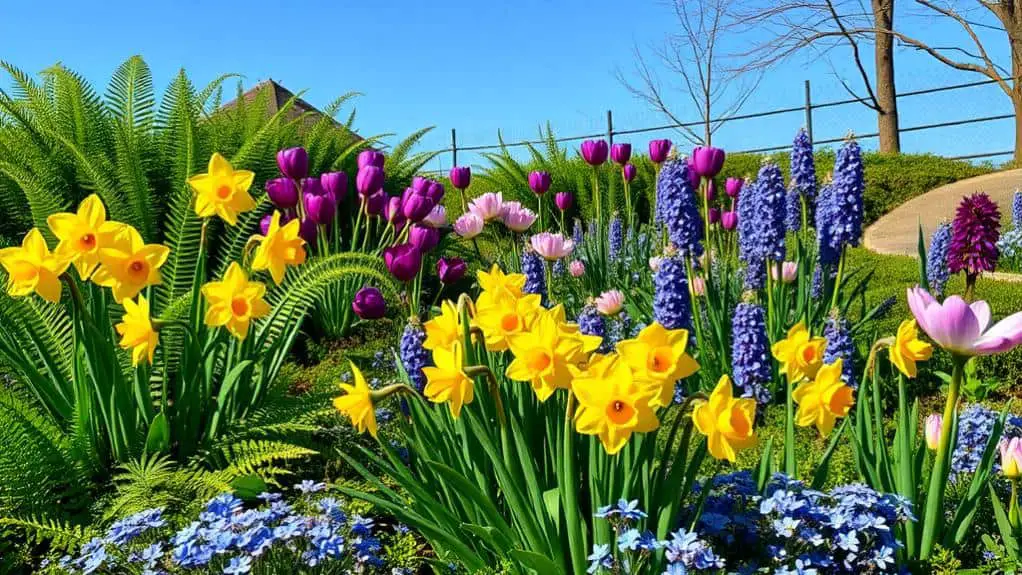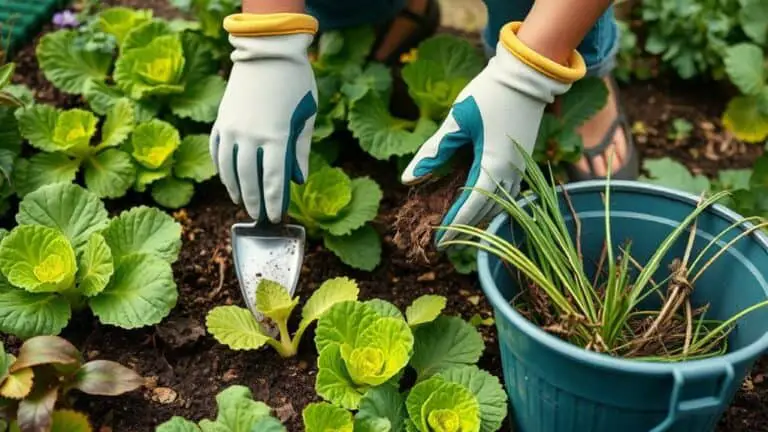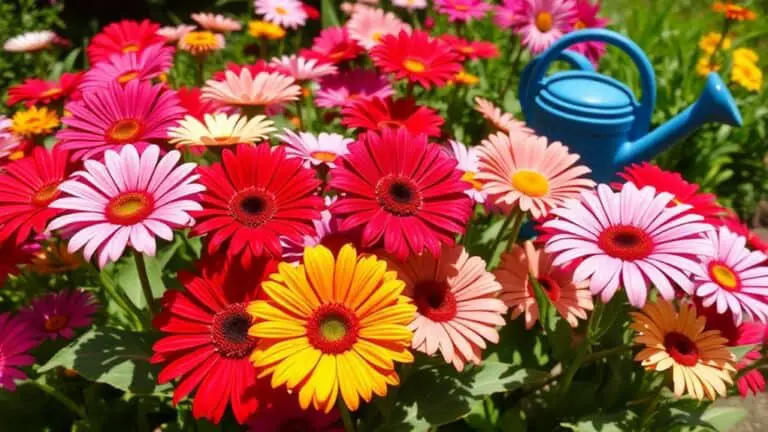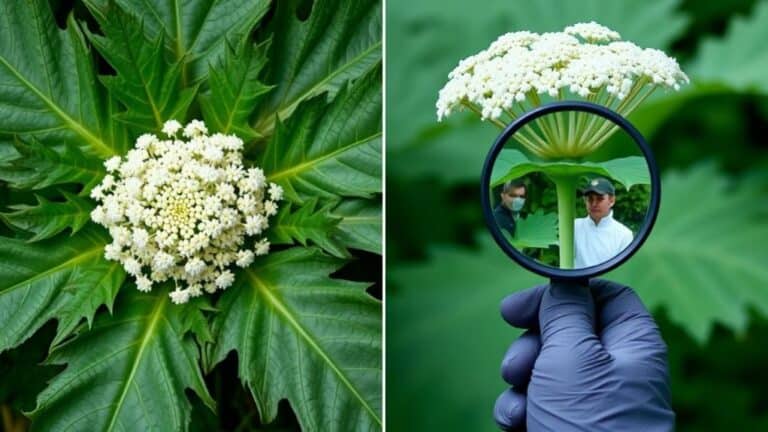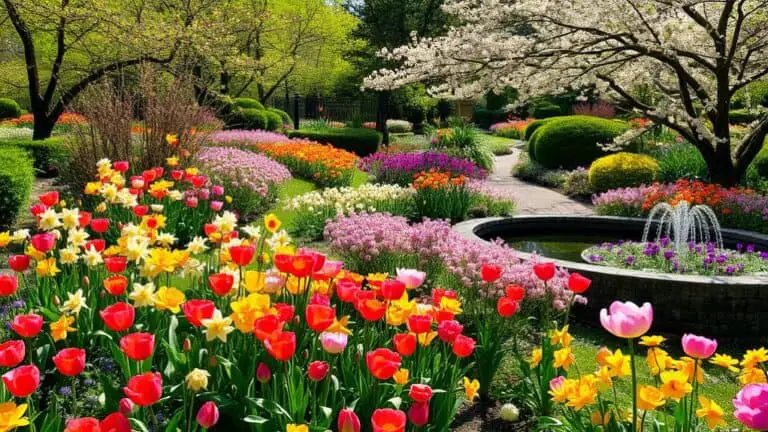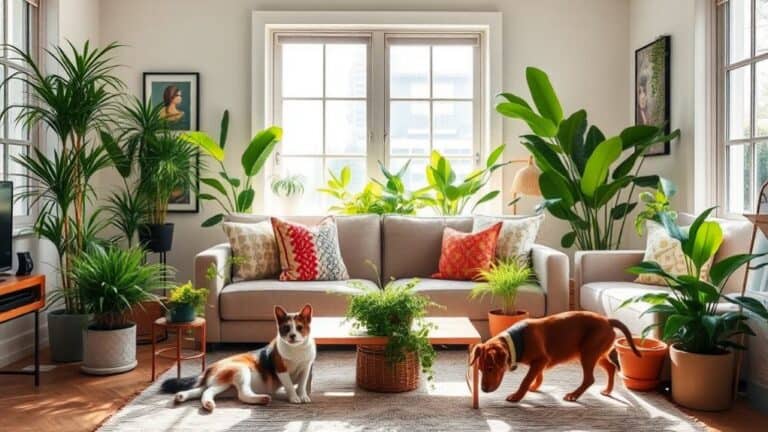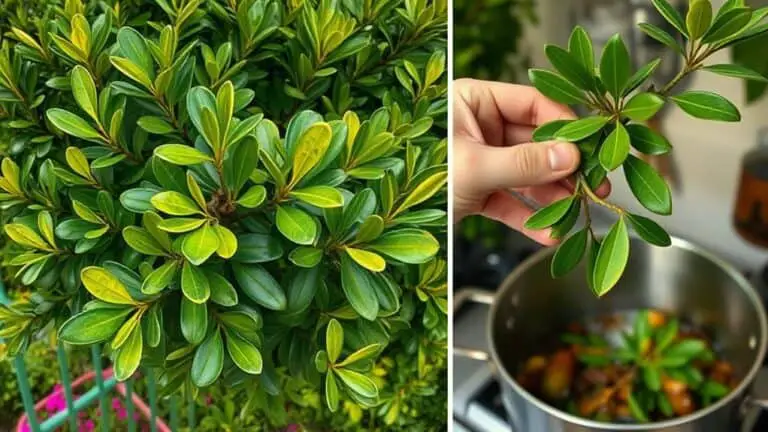Plants That Look The Best Next To Daffodils
When planning a garden, I've found that pairing daffodils with complementary plants can really elevate the overall aesthetic. Tulips and irises, for instance, bloom around the same time and add vibrant colors that contrast beautifully with the daffodils. Ground covers like heartleaf brunnera and hostas provide lush, green backdrops that hide the fading daffodil leaves. But that's just scratching the surface. There are more plants that not only look stunning beside daffodils but also offer practical benefits. Curious to know which ones and why they're perfect companions? Let's explore some intriguing options.
Tulips
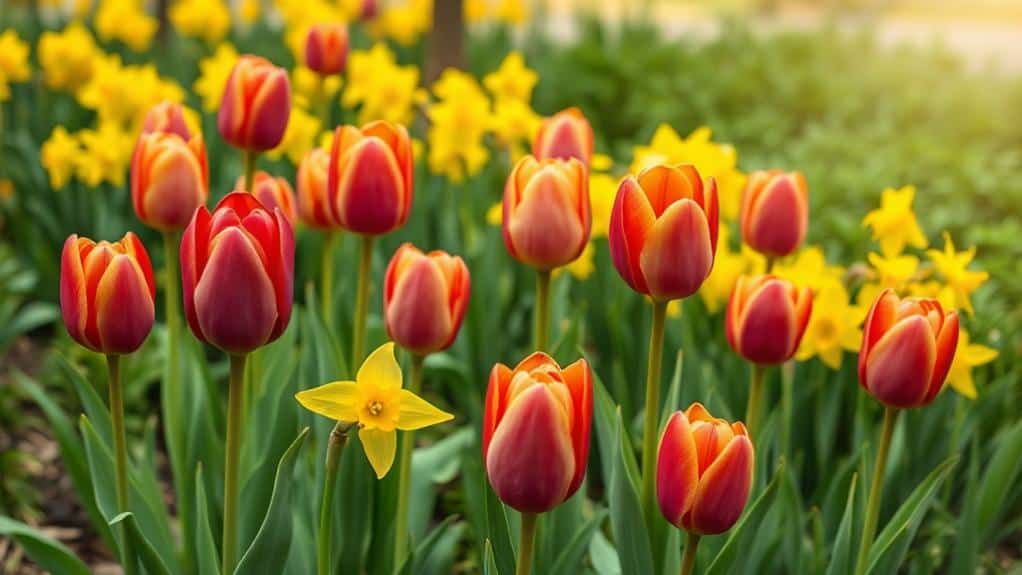
When it comes to pairing plants with daffodils, tulips are an excellent choice. They're hardy, cold-tolerant, and bloom around the same time, enhancing your garden's vibrant spring display.
Imagine a sea of colorful tulips in front of your daffodils, masking their fading foliage and keeping your garden's visual interest alive. Tulips come in an array of colors—yellow, orange, red, purple, white, and even multicolor—so you can get creative with your combinations.
They thrive in well-drained soil and full sun, perfect for the same environment daffodils love. Planting tulips in clusters next to daffodils not only looks stunning but also creates a cohesive and cheerful spring garden.
It's a match made in gardening heaven!
Irises
You can't go wrong with irises as a companion to daffodils in your garden.
Irises come in a wide range of colors like yellow, pink, blue, and purple, adding vibrant hues to your garden. They thrive in full sun or partial sun, which matches the light needs of daffodils, so both plants can flourish together.
Choose shorter varieties of irises to prevent them from overshadowing the daffodils, ensuring a balanced visual display. Since irises bloom concurrently with daffodils, they create a seamless progression of color in spring.
Being perennials, irises are low-maintenance and can naturalize easily, making them a perfect choice for a long-lasting, harmonious planting scheme with daffodils.
Heartleaf Brunnera
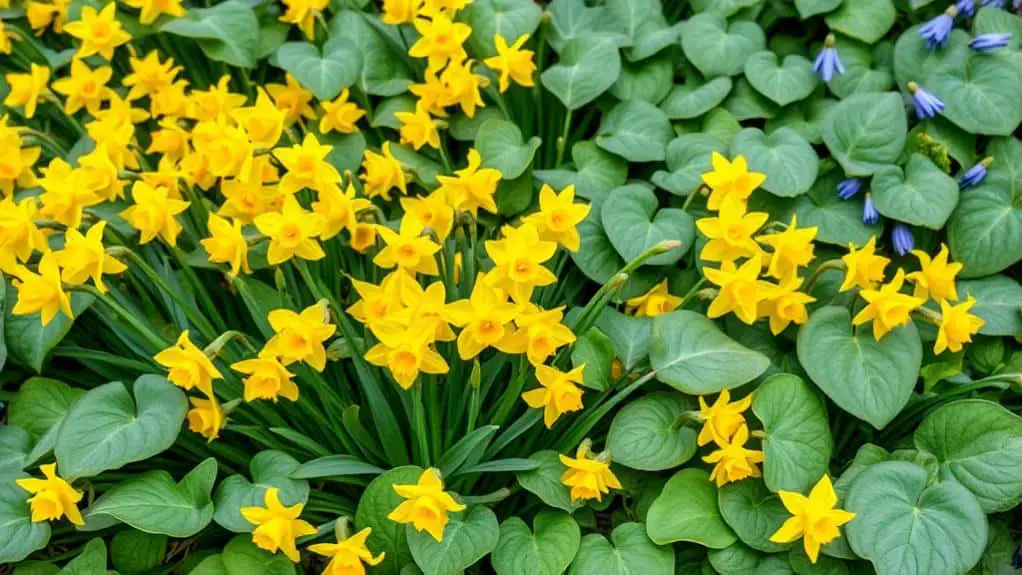
Heartleaf Brunnera, frequently admired for its striking heart-shaped leaves, makes a stunning companion to daffodils in the garden.
This perennial thrives in moist soil and prefers partial to full shade, which is perfect for hiding the fading foliage of the Narcissus genus as it dies back. The vibrant blue flowers of the Heartleaf Brunnera bloom in April and May, creating a beautiful color contrast with daffodils.
Standing at 12-18 inches tall, it provides a lush ground cover that complements the taller daffodil blooms. The dense foliage offers a lovely visual contrast to the daffodils' linear leaves, enhancing your garden's overall appeal.
Hardy in USDA zones 3-9, this plant is a versatile choice for various landscapes.
Crocus
Crocus bulbs are one of my favorite companions for daffodils because their early spring blooms create a lovely, colorful carpet that compliments the taller daffodils perfectly.
Their vibrant hues of blue, purple, orange, and yellow really make the bright yellows and whites of daffodils pop.
Plus, since they bloom at the same time, you'll enjoy a continuous burst of color in your garden.
Early Spring Blooms
As winter's grip begins to loosen, the vibrant crocus flowers make their appearance, heralding the arrival of early spring. Crocus are small, hardy bulbs that bloom around the same time as daffodils. Growing just 2 to 4 inches tall, they bring a burst of color to your garden. These bulbs are easy to plant in the fall and thrive in full to partial sun. The variety of crocus colors, from blue and purple to orange and yellow, creates a wonderful contrast with the yellows and whites of daffodils. Plus, crocuses are resilient and naturalize well, coming back year after year to delight you each spring.
| Crocus Colors | Emotions They Evoke |
|---|---|
| Blue and Purple | Calm and Serenity |
| Orange and Yellow | Joy and Warmth |
| Mixed Colors | Excitement |
| Spring Greenery | Renewal and Hope |
Complementary Color Pairing
When planning a spring garden, the interplay of colors can make a striking difference. Daffodil companion plants like Crocus bulbs are perfect for creating a complementary color pairing.
With their bright yellow blooms, daffodils pair beautifully with crocuses, which come in purple, yellow, and white hues. Planting crocus bulbs in clusters next to daffodils adds a stunning visual effect.
These low-growing plants, typically 2 to 4 inches tall, won't overshadow the taller daffodils. Both plants thrive in well-drained soil and full to partial sun, ensuring a healthy and vibrant garden.
Rhododendron
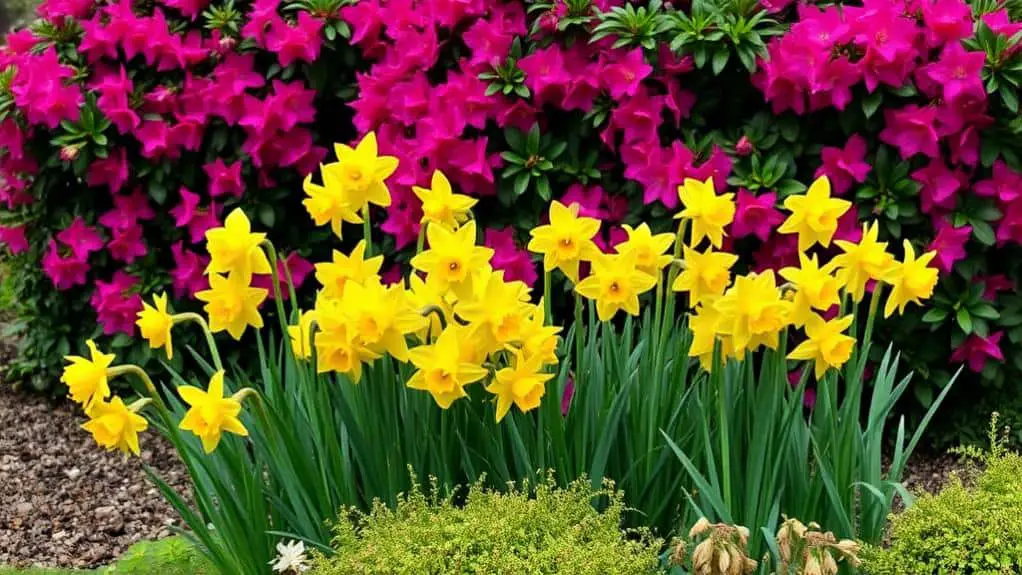
Rhododendrons are fantastic companions for daffodils in your garden. These flowering shrubs bloom in spring and summer, bringing vibrant colors that complement the early blooms of daffodils.
Rhododendrons thrive in USDA hardiness zones 4-9 and love well-drained, acidic soil with partial sun to partial shade. They can grow anywhere from 3 to 15 feet tall, making them perfect for layering behind shorter daffodils.
The large leaves of rhododendrons help mask the fading foliage of daffodils, creating a more appealing garden space. With their diverse color scheme, including pink, white, purple, and red, rhododendrons can enhance your garden's overall look.
They truly add beauty and charm alongside your cheerful daffodils.
Ligularia
Ligularia is a stunning perennial that pairs beautifully with daffodils, thanks to its striking bright yellow blooms.
As daffodils finish blooming in early spring, Ligularia's tall spikes and large, bold foliage create a lush backdrop. This helps conceal any wilting daffodil leaves, keeping your garden looking vibrant and tidy.
Ligularia thrives in partial to full shade, making it an excellent companion plant that provides much-needed shade for daffodils during their dormant period.
Plus, Ligularia's summer flowering extends your garden's color display well beyond the daffodils' season. It prefers moist soil, which keeps the ground around daffodil bulbs healthy and hydrated.
Together, they create a dynamic and colorful garden that's easy to maintain.
Hosta
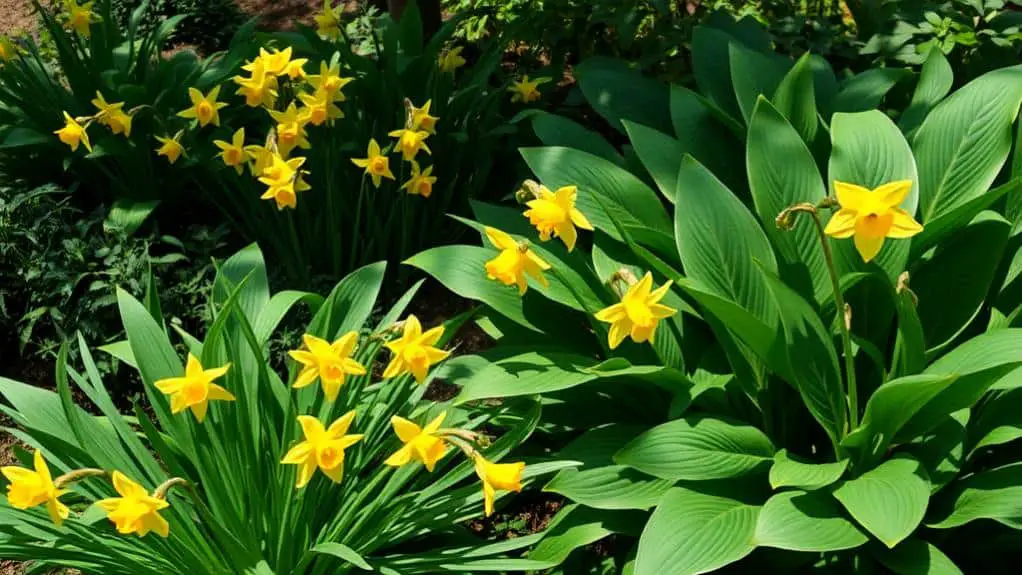
Hostas are an excellent choice for pairing with daffodils, especially if you're looking to add some texture and variety to your garden.
These shade-loving perennials thrive in partial to full shade, making them perfect companions for daffodils, which bloom in sunny spots before hostas fully emerge.
With heights ranging from 1 to 3 feet, hostas provide a lush backdrop that effectively conceals the wilting foliage of daffodils. Their diverse leaf shapes, sizes, and colors, including variegated varieties, enhance the garden's visual interest.
Blooming in summer, hostas produce delicate pink, blue, or lavender flowers, extending the garden's color palette.
Plus, they're low-maintenance and require well-drained soil, making them a practical and beautiful addition.
Muscari
Let's talk about Muscari, or grape hyacinths, which are fantastic companions for daffodils due to their vibrant blue, violet, and pink flowers that create a striking contrast.
These little bulbs grow about 6 to 12 inches tall, so they perfectly complement the height of daffodils while adding layers of color to your garden.
Plant them in the fall, and you'll enjoy a beautiful spring display as they bloom together, enhancing the visual appeal with their coordinated colors and growth patterns.
Complementary Color Schemes
In the world of complementary color schemes, Muscari stands out as a perfect partner for daffodils. These small, clustered flowering plants bloom in early spring, just like daffodils, creating a vibrant garden display.
While daffodils offer sunny yellows and whites, Muscari brings shades of blue, violet, and pink into the mix. The combination of these complementary colors brightens up any garden.
Since Muscari grows only 6-12 inches tall, it complements the taller daffodils without overshadowing them. Both plants thrive in well-drained soil and full to partial sun, making them easy to pair.
Planting Muscari in clusters around daffodils enhances the overall aesthetic, providing a striking contrast and harmonious blend of colors.
Height and Growth Patterns
While complementary color schemes play a significant role in creating a visually stunning garden, understanding the height and growth patterns of Muscari is equally important. Muscari, or grape hyacinths, typically grow to a height of 6 to 12 inches. This makes them a perfect low-growing companion for the taller daffodils. Their dense clusters of blue, violet, and pink flowers provide a vibrant contrast against the yellow daffodil blooms. Planting Muscari around daffodils not only enhances visual appeal but also effectively masks the fading daffodil foliage. The narrow, grass-like foliage of Muscari blends well without overshadowing the larger daffodil leaves.
| Plant | Height | Blooming Season |
|---|---|---|
| Daffodils | 12-24 inches | Early Spring |
| Muscari | 6-12 inches | Early Spring |
Seasonal Bloom Coordination
Coordinating the bloom times of Muscari and daffodils guarantees a harmonious and vibrant spring display. Both of these spring bulbs bloom around the same time, making them suitable companions in your garden.
Muscari, also known as grape hyacinths, add a lovely contrast with their blue, violet, or pink flowers against the daffodils' bright yellow flowers. Since Muscari grows to about 6-12 inches, they complement the taller daffodils without overshadowing them.
Both plants thrive in well-drained soil and full sun, ensuring they'll flourish together.
Planting Muscari in clusters next to daffodils enhances the visual impact, creating a stunning and colorful garden. It's a simple way to make your spring garden burst with life and color!
Hellebore
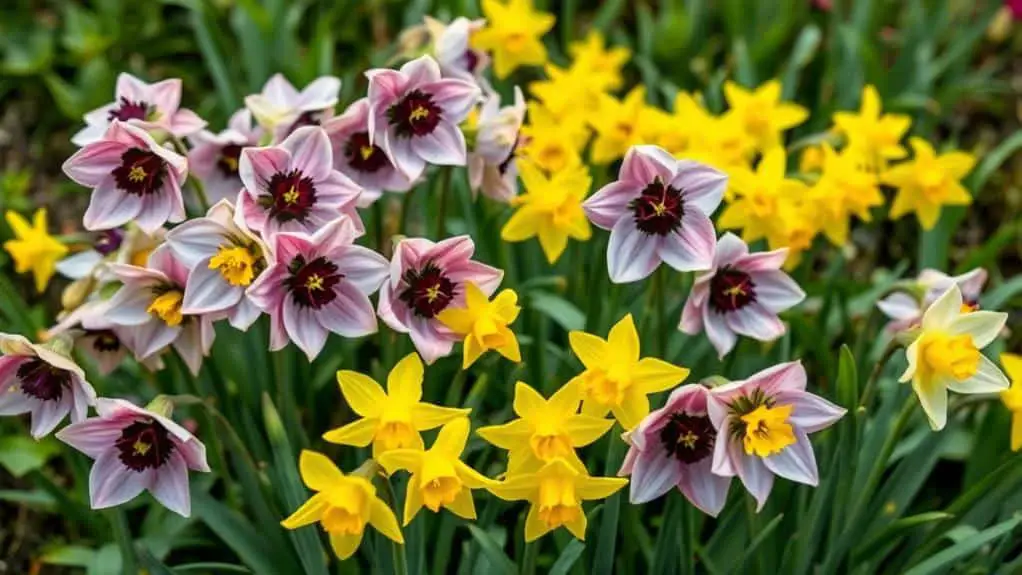
When planning a spring garden, Hellebore, often called Lenten rose, stands out as a stellar companion for daffodils. Blooming between Christmas and Easter, Hellebore brings vibrant color to your garden just as daffodils start to shine.
Their showy flowers, ranging from white to burgundy, contrast beautifully with daffodils' bright yellow. Both plants thrive in partial shade, making them perfect companion plants.
Hellebore grows to a height of 1 to 2 feet, complementing the shorter daffodil foliage nicely. Plus, Hellebore loves moist soil, which helps keep the ground suitable for daffodils.
Adding Hellebore to your garden guarantees a colorful, harmonious spring display that's both eye-catching and easy to manage.
Allium
Allium, with its striking purple blooms, makes a fantastic companion for daffodils, adding a burst of vibrant color to your garden.
Not only do Alliums share the same ideal growth conditions—full sun and well-drained soil—but they also help keep pests away, protecting your daffodils.
Plus, their spherical flower heads create an eye-catching contrast to the daffodils' sunny hues, making your garden look even more beautiful.
Attractive Purple Blooms
Imagine the garden awash with the vibrant hues of late spring, where the fading golden trumpets of daffodils give way to the stunning purple globes of Allium.
These purple flowers bloom later, creating a seamless shift in your garden's color palette. Alliums, reaching up to 48 inches, add height and visual interest, perfectly complementing the shorter daffodils.
Thriving in full sun and well-drained soil, they're ideal companion plants for daffodils. Their spherical flower heads not only attract pollinators, enhancing garden biodiversity, but also provide a striking contrast to the trumpet-shaped daffodil blooms.
As daffodils fade, Alliums maintain the garden's vibrancy, ensuring continuous beauty from late spring into early summer.
Pest-Repelling Properties
Beyond their striking appearance, Alliums bring another valuable trait to the garden: pest-repelling properties.
These plants, commonly known as ornamental onions, contain sulfur compounds that are toxic to many pests. This makes them a natural and effective pest deterrent. When you plant Allium near daffodils, you'll find that pests like aphids, slugs, and even deer are kept at bay.
The strong scent of Allium confuses and repels harmful insects, creating a protective barrier for your flowers. Plus, Allium can grow up to 36 inches tall, adding visual height and interest to your garden.
Ideal Growth Conditions
When planting Allium, it's important to provide well-drained soil and plenty of sunlight to guarantee they thrive. These bulbs love full sun, which helps them grow and produce their stunning blooms.
Allium is a good companion for daffodils since they both bloom in spring, adding beautiful color to your garden. Plant the bulbs in the fall, so they can establish roots before winter.
Their unique pom-pom-like flowers not only look great but also attract pollinators. Space them properly to promote good air circulation and prevent overcrowding.
With heights from 3 to 18 inches, Allium adds vertical interest next to shorter daffodils, creating a dynamic and eye-catching display in your garden.
Frequently Asked Questions
What to Plant Next to Daffodil?
When considering companion planting, I recommend daylilies and tulips for color contrast and seasonal blooms. Grape hyacinths add low-growing texture, while forsythia offers height variations. Heartleaf Brunnera provides maintenance ease by hiding fading foliage effectively.
Where Not to Plant Daffodils?
I wouldn't plant daffodils near trees or heavy feeders due to soil drainage and light requirements. For disease prevention and pest control, keep them away from annuals and plants that attract pests. Companion planting guarantees seasonal blooms thrive.
Can Daffodils and Irises Be Planted Together?
Yes, you can plant daffodils and irises together. Their compatibility is great for companion planting. With proper iris care, the color contrast in your flower arrangement will enhance your garden's beauty during their seasonal blooms.
Should You Put Daffodils With Other Flowers?
You should put daffodils with other flowers. Companion planting with seasonal blooms offers color contrast, enhances soil compatibility, and helps deter pests. Choose plants with complementary growth habits to guarantee a thriving, visually pleasing garden.
Conclusion
So, if you're thinking about jazzing up your garden, pair your daffodils with tulips, irises, or muscari for a burst of color. Ground covers like heartleaf brunnera and hostas will keep things lush and neat. Don't forget the alliums—they're not just pretty but also keep pests away. With these plant buddies, your garden will be both beautiful and healthy. Give it a try, and watch your garden come to life!

